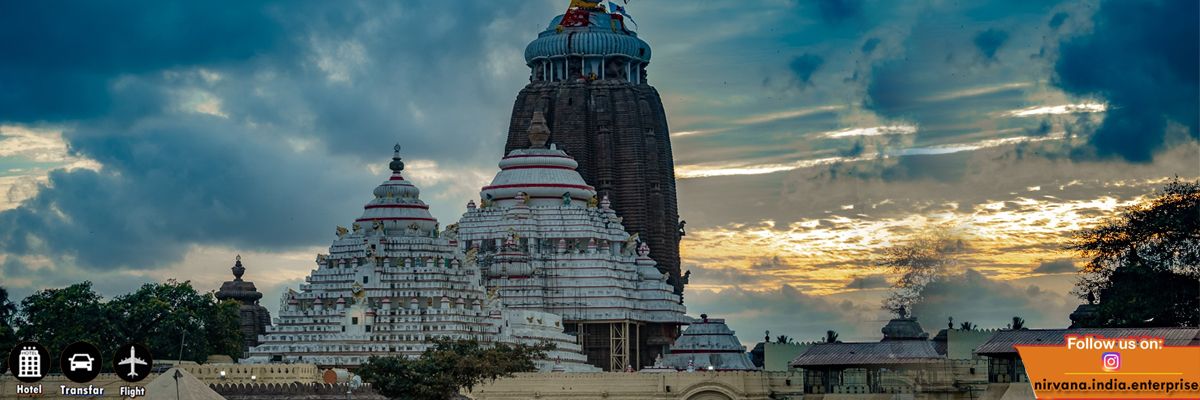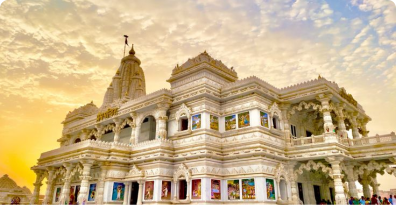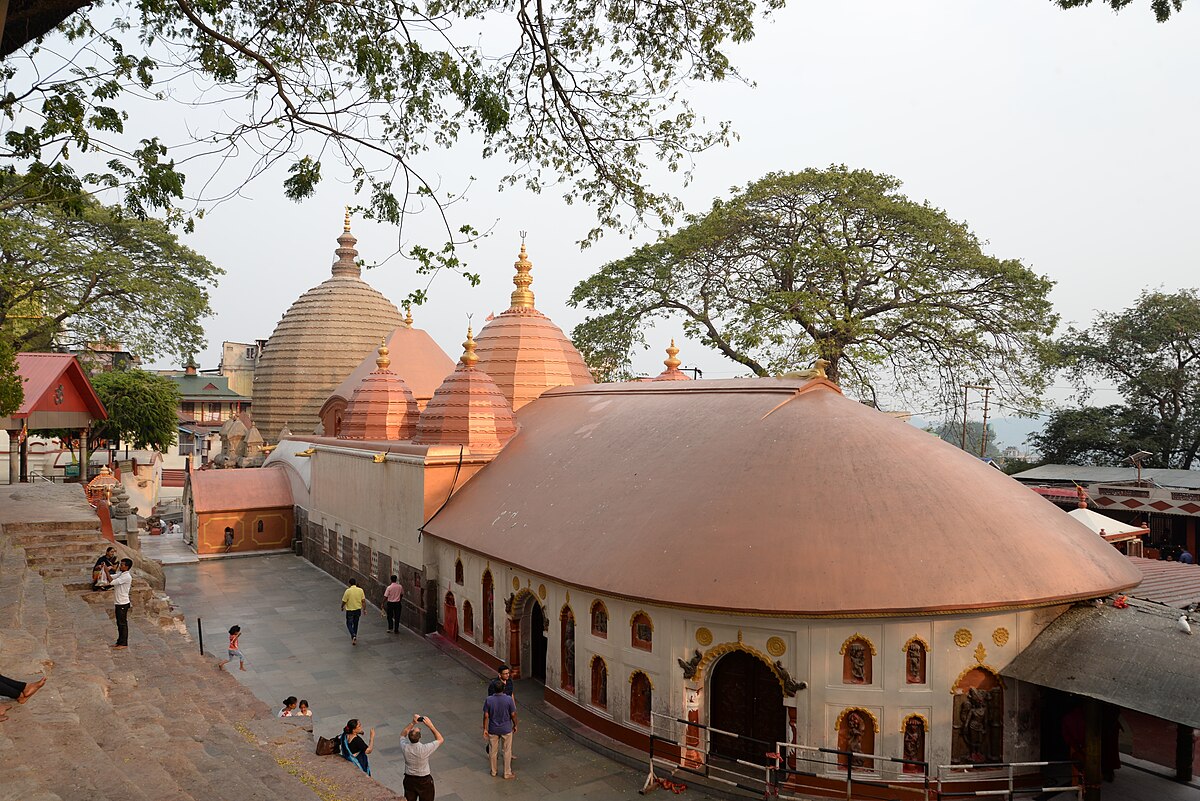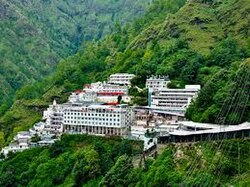
October 06, 2025
Temple Mandir
6 min read
Jagannath Temple
Situated in the holy city of Puri, Odisha, the Jagannath Temple is one of India’s most iconic and spiritually significant pilgrimage sites. Dedicated to Lord Jagannath, a form of Lord Krishna, along with his siblings Balabhadra and Subhadra, the temple is renowned for its grand rituals, vibrant festivals, and the legendary Rath Yatra—the annual chariot festival that draws millions of devotees from around the world. Built in the 12th century, the temple’s magnificent architecture, intricate carvings, and towering spire reflect Odisha’s rich cultural heritage. Legends say that a visit to this sacred shrine ensures divine blessings, spiritual upliftment, and fulfillment of heartfelt wishes. The Jagannath Temple is not just a center of devotion; it is a living testament to India’s timeless tradition of faith, community, and celebration.
Jagannath Temple, Puri: The Sacred Abode of Lord Jagannath
Introduction
The Jagannath Temple, located in Puri, Odisha, is one of the four cardinal Char Dham pilgrimage sites in India and a major center of Vaishnavism. Dedicated to Lord Jagannath (a form of Lord Krishna), along with his siblings Balabhadra and Subhadra, the temple is revered for its unique rituals, grand festivals, and spiritual significance.
Puri, situated on the eastern coast of India, is known as “Srikshetra”, meaning the holy land of Lord Vishnu. The temple attracts millions of devotees every year, who come to seek blessings, participate in the legendary Rath Yatra, and immerse themselves in centuries-old traditions.
The Jagannath Temple is not just a religious site but a cultural and historical treasure, symbolizing devotion, art, and spiritual continuity. Pilgrims believe that a visit here can purify the soul, fulfill desires, and bring prosperity and peace.
Historical Background
The origins of the Jagannath Temple are intertwined with ancient myths, dynastic patronage, and architectural grandeur. While the exact date of establishment is debated, most historians agree that the present temple was constructed in the 12th century by King Anantavarman Chodaganga Deva of the Eastern Ganga dynasty.
The temple is famed for its Kalinga-style architecture, featuring a massive Rekha Deula (sanctum tower), intricately carved pillars, and expansive courtyards. The main sanctum houses the deities in a wooden form, which is distinct from other Hindu temples where idols are usually stone or metal.
Legends suggest that the deities of Jagannath, Balabhadra, and Subhadra were originally self-manifested (Swayambhu), and the wooden forms were carved to preserve their divine presence. The temple complex also includes Nandighosa (tower clock), Ananda Bazar, and the Gundicha Temple, adding to its cultural and architectural importance.
Myths & Stories
The Jagannath Temple is steeped in mythology and fascinating stories. One of the most famous legends is that of King Indradyumna, who, guided by a divine dream, built the temple to house the deities of Jagannath, Balabhadra, and Subhadra. The deities were carved from Neem wood, and it is believed that their mysterious wooden forms are replaced every 12 or 19 years in a sacred ritual called Navakalevara, symbolizing the cyclical nature of life and divinity.
Another story tells of Lord Krishna and his siblings taking a divine form to reside permanently in Puri to bless humanity. The temple rituals, including the daily offerings and ceremonial worship, are said to recreate the intimate presence of the deities, connecting devotees to the divine family.
The Rath Yatra, one of the world’s largest chariot festivals, celebrates Lord Jagannath’s annual journey to Gundicha Temple, symbolizing his visit to his birthplace. Legends narrate miraculous incidents where the deities have protected the city from calamities, droughts, and invasions, enhancing the temple’s mystical aura.
Local tales recount that even kings and invaders could not violate the sanctity of the temple due to divine protection, adding to the sense of awe and reverence that surrounds the shrine.
Festivals & Rituals
The Jagannath Temple is alive with daily rituals and grand festivals. The most famous is the Rath Yatra, held annually in June–July, when millions of devotees pull massive wooden chariots carrying the deities through the streets of Puri. This festival symbolizes the Lord’s accessibility to all, regardless of caste, creed, or religion.
Other important festivals include Snana Yatra (bathing ceremony), Chandan Yatra, and Makara Sankranti, each with elaborate rituals, music, and cultural performances. Daily worship at the temple follows a strict schedule, including Mangal Aarti (morning worship), Bhoga (food offerings), and Sandhya Aarti (evening prayer).
A unique feature of the temple is the Mahaprasad, a sacred food offering that is cooked in earthen pots and distributed to devotees. The preparation follows strict traditional methods and is considered highly auspicious, with millions partaking in this divine offering every year.
The Navakalevara ritual, performed every 12 or 19 years, involves replacing the old wooden deities with newly carved ones, symbolizing the cycle of life and death. This ritual attracts devotees and scholars from around the world due to its spiritual significance and meticulous execution.
Visitor Experience
Visiting the Jagannath Temple is a spiritual and cultural journey. The temple is located in the heart of Puri, with nearby beaches, markets, and pilgrimage centers enriching the experience. Pilgrims often plan their visit to coincide with Rath Yatra to witness the spectacular chariot procession and participate in the communal devotion.
The temple provides facilities for darshan (viewing of the deity), accommodation, and guided tours, making it accessible for both domestic and international visitors. Security and crowd management are strict, especially during festivals, ensuring a smooth and safe experience.
Exploring the temple complex reveals intricate stone carvings, sacred tanks, and halls that narrate stories from Hindu epics. Nearby attractions like the Gundicha Temple, Konark Sun Temple, and Chilika Lake offer cultural and natural exploration, complementing the spiritual experience.
The Mahaprasad, local Odia cuisine, and vibrant bazaars add a unique cultural flavor to the pilgrimage, making it an immersive journey for both the soul and the senses.
Spiritual Significance
The Jagannath Temple is a major spiritual center of Vaishnavism, where devotion, ritual, and culture converge. Devotees believe that visiting the temple and participating in its rituals can purify the soul, remove sins, and bring prosperity.
Lord Jagannath, along with Balabhadra and Subhadra, represents the divine family, emphasizing values of love, unity, and protection. The unique wooden idols are believed to radiate spiritual energy, creating an immersive environment for meditation, prayer, and contemplation.
The temple’s role as part of the Char Dham pilgrimage enhances its significance, connecting devotees to a sacred circuit believed to grant liberation (Moksha). The daily rituals, festive celebrations, and devotional practices create a continuous spiritual resonance, reinforcing faith and devotion across generations.
Conclusion
The Jagannath Temple of Puri stands as a timeless symbol of devotion, culture, and divine grace. From its mythical origins and miraculous legends to the grandeur of its festivals and sacred rituals, the temple continues to inspire millions worldwide.
A visit to Jagannath Temple is not merely a physical journey but a spiritual odyssey, where devotees experience the divine presence of Lord Jagannath, witness ancient traditions, and immerse themselves in the cultural richness of Odisha.
Whether you are a devotee seeking blessings, a traveler exploring history, or an enthusiast of Indian culture, the Jagannath Temple offers an unforgettable experience of faith, devotion, and divine wonder.
The towering chariots, sacred deities, and centuries-old rituals serve as a reminder of the eternal presence of the divine in human life, continuing to guide, protect, and inspire generations of pilgrims and visitors.
Introduction
The Jagannath Temple, located in Puri, Odisha, is one of the four cardinal Char Dham pilgrimage sites in India and a major center of Vaishnavism. Dedicated to Lord Jagannath (a form of Lord Krishna), along with his siblings Balabhadra and Subhadra, the temple is revered for its unique rituals, grand festivals, and spiritual significance.
Puri, situated on the eastern coast of India, is known as “Srikshetra”, meaning the holy land of Lord Vishnu. The temple attracts millions of devotees every year, who come to seek blessings, participate in the legendary Rath Yatra, and immerse themselves in centuries-old traditions.
The Jagannath Temple is not just a religious site but a cultural and historical treasure, symbolizing devotion, art, and spiritual continuity. Pilgrims believe that a visit here can purify the soul, fulfill desires, and bring prosperity and peace.
Historical Background
The origins of the Jagannath Temple are intertwined with ancient myths, dynastic patronage, and architectural grandeur. While the exact date of establishment is debated, most historians agree that the present temple was constructed in the 12th century by King Anantavarman Chodaganga Deva of the Eastern Ganga dynasty.
The temple is famed for its Kalinga-style architecture, featuring a massive Rekha Deula (sanctum tower), intricately carved pillars, and expansive courtyards. The main sanctum houses the deities in a wooden form, which is distinct from other Hindu temples where idols are usually stone or metal.
Legends suggest that the deities of Jagannath, Balabhadra, and Subhadra were originally self-manifested (Swayambhu), and the wooden forms were carved to preserve their divine presence. The temple complex also includes Nandighosa (tower clock), Ananda Bazar, and the Gundicha Temple, adding to its cultural and architectural importance.
Myths & Stories
The Jagannath Temple is steeped in mythology and fascinating stories. One of the most famous legends is that of King Indradyumna, who, guided by a divine dream, built the temple to house the deities of Jagannath, Balabhadra, and Subhadra. The deities were carved from Neem wood, and it is believed that their mysterious wooden forms are replaced every 12 or 19 years in a sacred ritual called Navakalevara, symbolizing the cyclical nature of life and divinity.
Another story tells of Lord Krishna and his siblings taking a divine form to reside permanently in Puri to bless humanity. The temple rituals, including the daily offerings and ceremonial worship, are said to recreate the intimate presence of the deities, connecting devotees to the divine family.
The Rath Yatra, one of the world’s largest chariot festivals, celebrates Lord Jagannath’s annual journey to Gundicha Temple, symbolizing his visit to his birthplace. Legends narrate miraculous incidents where the deities have protected the city from calamities, droughts, and invasions, enhancing the temple’s mystical aura.
Local tales recount that even kings and invaders could not violate the sanctity of the temple due to divine protection, adding to the sense of awe and reverence that surrounds the shrine.
Festivals & Rituals
The Jagannath Temple is alive with daily rituals and grand festivals. The most famous is the Rath Yatra, held annually in June–July, when millions of devotees pull massive wooden chariots carrying the deities through the streets of Puri. This festival symbolizes the Lord’s accessibility to all, regardless of caste, creed, or religion.
Other important festivals include Snana Yatra (bathing ceremony), Chandan Yatra, and Makara Sankranti, each with elaborate rituals, music, and cultural performances. Daily worship at the temple follows a strict schedule, including Mangal Aarti (morning worship), Bhoga (food offerings), and Sandhya Aarti (evening prayer).
A unique feature of the temple is the Mahaprasad, a sacred food offering that is cooked in earthen pots and distributed to devotees. The preparation follows strict traditional methods and is considered highly auspicious, with millions partaking in this divine offering every year.
The Navakalevara ritual, performed every 12 or 19 years, involves replacing the old wooden deities with newly carved ones, symbolizing the cycle of life and death. This ritual attracts devotees and scholars from around the world due to its spiritual significance and meticulous execution.
Visitor Experience
Visiting the Jagannath Temple is a spiritual and cultural journey. The temple is located in the heart of Puri, with nearby beaches, markets, and pilgrimage centers enriching the experience. Pilgrims often plan their visit to coincide with Rath Yatra to witness the spectacular chariot procession and participate in the communal devotion.
The temple provides facilities for darshan (viewing of the deity), accommodation, and guided tours, making it accessible for both domestic and international visitors. Security and crowd management are strict, especially during festivals, ensuring a smooth and safe experience.
Exploring the temple complex reveals intricate stone carvings, sacred tanks, and halls that narrate stories from Hindu epics. Nearby attractions like the Gundicha Temple, Konark Sun Temple, and Chilika Lake offer cultural and natural exploration, complementing the spiritual experience.
The Mahaprasad, local Odia cuisine, and vibrant bazaars add a unique cultural flavor to the pilgrimage, making it an immersive journey for both the soul and the senses.
Spiritual Significance
The Jagannath Temple is a major spiritual center of Vaishnavism, where devotion, ritual, and culture converge. Devotees believe that visiting the temple and participating in its rituals can purify the soul, remove sins, and bring prosperity.
Lord Jagannath, along with Balabhadra and Subhadra, represents the divine family, emphasizing values of love, unity, and protection. The unique wooden idols are believed to radiate spiritual energy, creating an immersive environment for meditation, prayer, and contemplation.
The temple’s role as part of the Char Dham pilgrimage enhances its significance, connecting devotees to a sacred circuit believed to grant liberation (Moksha). The daily rituals, festive celebrations, and devotional practices create a continuous spiritual resonance, reinforcing faith and devotion across generations.
Conclusion
The Jagannath Temple of Puri stands as a timeless symbol of devotion, culture, and divine grace. From its mythical origins and miraculous legends to the grandeur of its festivals and sacred rituals, the temple continues to inspire millions worldwide.
A visit to Jagannath Temple is not merely a physical journey but a spiritual odyssey, where devotees experience the divine presence of Lord Jagannath, witness ancient traditions, and immerse themselves in the cultural richness of Odisha.
Whether you are a devotee seeking blessings, a traveler exploring history, or an enthusiast of Indian culture, the Jagannath Temple offers an unforgettable experience of faith, devotion, and divine wonder.
The towering chariots, sacred deities, and centuries-old rituals serve as a reminder of the eternal presence of the divine in human life, continuing to guide, protect, and inspire generations of pilgrims and visitors.


